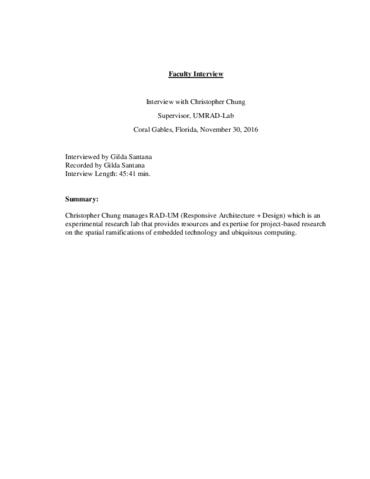Identity elements
Name and location of repository
Level of description
Item
Title
Interview Christopher Chung, 30 November 2016
Date(s)
- 11/30/2016 (Creation)
Extent
PDF document.
Name of creator
Biographical history
Gilda Santana joined the faculty of the University of Miami Libraries in 2007 as Head of Architecture Information and Resources to direct the Paul Buisson Architecture Library. She led the expansion and redesign of the library now called the Architecture Research Center (ARC) in 2018. Her research interests include facilitating the culture of design research through studio embedded-librarianship and the evolution of digital humanities in architecture and the arts. In 2013 she became the Librarian for Art & Art History. Santana has a Master of Science in Architecture from the School of Architecture, University of Miami, a Master’s in Library and Information Science from Rutgers, The State University of New Jersey, and a Bachelor of Art from Bard College where she majored in Art History. She actively serves in the Association of Architecture School Librarians (AASL) and the Art Libraries Association of North America (ARLIS).
Name of creator
Biographical history
Completing his Masters in Architecture at the University of Toronto in 2014, Chris draws from his education, experience and interests in Design, Computer Science, Digital Fabrication, and Physical Computing to help develop and manage RAD-UM, a research lab dedicated for project-based research on the spatial ramifications of embedded technology and ubiquitous computing. Located at the University of Miami's School of Architecture, RAD’s research is premised on the notion that every building or landscape component can be equipped with computational power. Over the last several years, Chris has overseen the growth of RAD-UM and its projects like Cof-e-Bar, Bio-Display, Zenciti, and Robotic Cloud. His interests lie in bridging the digital and the physical realms within the public arena, particularly in ways that can create new and exciting social interactions.
Content and structure elements
Scope and content
Interview to professor Christopher Chung by Gilda Santana. Interview Length: 45:41 min.

